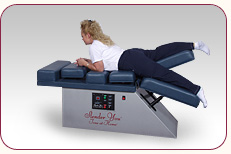Motorized toning tables are a home exercise product that claims to strengthen muscles and increase flexibility and endurance. Other advertised benefits include providing a low-impact workout and reducing the likelihood of injury. Toning tables are ideal for geriatric populations due to the relaxation of over-used muscles and tightening of under-used muscles; this is done through the equal stimulation of deeply positioned postural control muscles. They are also reported to tone and tighten stomach and shoulder muscles to re-position the rib cage, pelvis and shoulders. They also attempt to stimulate increased blood, lymph and general body fluid circulation, which has been found to be problematic in people who find normal exercise and even walking difficult.
History
Toning tables are based off the original design developed by biochemist Bernard H. Stauffer (United States) in the 1930s. His knowledge of the physiology, anatomy and movement patterns of the body enabled him to develop the Induced Rhythmic Motion (IRM) tables.[1]
Criticism
While critics agree that toning tables work to relax tense muscles, there is little evidence that they offer enough resistance to facilitate any substantial strength gains or burn enough calories facilitate "toning".[2]
External Links
Notes
- ↑ Andrew Mackey (April 16 2007). What is a Toning Table?. WorldWideHealth.com. Retrieved on 2008-03-14.
- ↑ www.stason.org. Does Passive Exercise Work?. Retrieved on 2008-03-13.
| |||||
